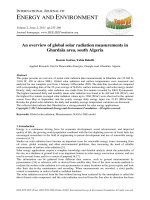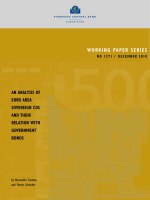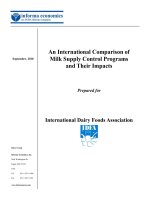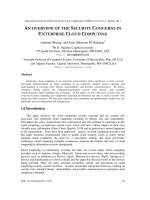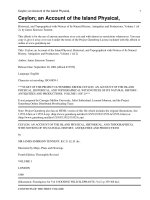An overview of major finfish species landing in Chellanam Harbour of Ernakulam district, Kerala (India) and their conservation status
Bạn đang xem bản rút gọn của tài liệu. Xem và tải ngay bản đầy đủ của tài liệu tại đây (317.29 KB, 6 trang )
Int.J.Curr.Microbiol.App.Sci (2020) 9(8): 3324-3329
International Journal of Current Microbiology and Applied Sciences
ISSN: 2319-7706 Volume 9 Number 8 (2020)
Journal homepage:
Original Research Article
/>
An Overview of Major Finfish Species Landing in Chellanam Harbour of
Ernakulam District, Kerala (India) and their Conservation Status
Davood Nihal1*, N.M. Naseem2, N.S. Surjith1 and C. Mohammed Salih1
1
Department of Aquatic Environment Management, 2Department of Fisheries Resource
Management, KUFOS, Kochi, India
*Corresponding author
ABSTRACT
Keywords
Fish diversity,
Chellanam, IUCN
red list,
Conservation status
Article Info
Accepted:
26 July 2020
Available Online:
10 August 2020
The present study primarily focused on systematic representation of IUCN
(International Union for Conservation of Nature) Red Listed marine finfish
landings of Chellanam harbour of Ernakulam district, Kerala. The study
was conducted for a period of 6 months from November 2018 to April
2019. Sample collections were conducted twice in a month. A checklist of
finfishes along with their scientific name, common name, family and
present conservation status were prepared. A total of 41 species of fishes
belonging to 24 families were identified during the entire study. As per
IUCN (International Union for Conservation of Nature) Red List (2017-3),
out of 41 fish species identified, 1 species comes under Near Threatened
(NT), 1 species comes under Vulnerable (VU), 2 species comes under Data
Deficient (DD), 31 species comes under Least Concern (LC) and 6 species
comes under Not Evaluated (NE). Information on conservation status of
fishes plays a significant role in fisheries science since it forms basis for
management of marine fishery resources.
Introduction
As a tropical country, India boasts a rich
diversity of flora and fauna and is listed
among the world's mega biodiversity
countries, however with a delicate ecosystem
(Yadav, 1997). As fishery resources have
multiple uses, fishing has become a major
industry in developing countries such as India
and has provided livelihoods for a number of
people. Fishery resources are sustainable
natural resources, yet are liable to extinction
(as witnessed in several cases worldwide) if
persistent and indiscriminate harvesting is
adopted (Narayanakumar, 2017). Marine
ecosystems are ecologically significant as
they support high biodiversity and a wide
range of fish species, but these coastal
environments are remarkably sensitive to
increasing anthropogenic activities and
3324
Int.J.Curr.Microbiol.App.Sci (2020) 9(8): 3324-3329
related climate changes (Luypaert et al.,
2019). There is growing concern about the
increasing human effect that has occurred in
recent years on marine biodiversity (Jackson,
2010). According to (Joshy, 2017) marine and
coastal waters of Kerala are considered as the
most significant ecosystems in terms of
productivity
and
uniqueness.
Highly
flourished marine resources, abundant number
of fish diversity and skilled fishing
community are the driving forces which lead
Kerala into a major producer and consumer in
the field of fisheries. Favourable high rainfall,
long coastline and a numerous numbers of
rivers make the Kerala coast more productive
for fishery. The Chellanam fishing harbour is
a small fishing harbour, situated in the
Kandekkadu gap of Chellanam Panchayath in
Ernakulam District of Kerala. This region is
rich in fishery resources and often mudbanks
are formed here. The nearest established
fishing port is at Thoppumpady, 20 km north
of Chellanam, where there is no beach
landing facility. The fishermen engaged in
fishing and related activities here are from
South Chellanam Matsyagramam. About 220
motorized boats called valloms and 25
inboard valloms are operating from this area.
The assessment of the major marine fish
reported from the study area with categories
and criteria of IUCN (International Union for
Conservation of Nature) Red List not only
determines their conservation status but also
helps to formulate sustainable fisheries
management strategies. The present work is
an effective attempt to identify major
finfishes and determine the conservation
status, reported in the Chellanam harbour of
Ernakulam district.
Materials and Methods
The study area (Lat. 09°47′950″N, Long.
76°16′551″E) is located in the Chellanam
Panchayath of Ernakulam District (Fig. 1),
250 metres west of Thoppumpady -
Chellanam State Highway and 8.5 km from
the N.H 47 at Eramalloor junction.
Investigation regarding fish landing along
with sample collection were conducted twice
in a month and harbour visit were made on
early morning (6 A.M) for a period of six
months from November 2018 to April 2019.
All images of fishes were captured with a
Canon IXUS 190 digital camera. The
collected fishes were identified using standard
references and keys (Misra, 1952; Ebert and
Mostarda, 2013; List of Fish Species; Fish
Base). During the auction time, the fish
samples were collected randomly from each
heap. All collected samples were brought to
the laboratory, washed thoroughly with tap
water, and stored in 10% formalin for further
examination. To supplement the sampling
data, information regarding other than
reported catch was collected from fishermen
by questionnaire survey method. The fishes
identified were classified in compliance with
the status of the IUCN (International Union
for Conservation of Nature) Red List and also
the different schedules of the Indian Wildlife
Act (Protection) and the appendices of the
Convention on International Trade in
Endangered Species of Wild Fauna and Flora
(CITES) (IUCN Red List 2017-3).
Results and Discussion
A total of 41 species of fishes belonging to 24
families were identified during the entire
study. Scientific names of the 41 species of
fishes, with family, common name and IUCN
status are shown in Table 1 and the details of
number of species representing each family
are shown in figure 3. Out of 24 families,
Engraulidae dominated first with five species
of fishes including Encrasicholina punctifer,
Stolephorus
commersonnii,
Stolephorus
indicus, Thryssa mystax and Thryssa
setirostris. Carangidae and Clupeidae
secondly dominated representing 4 species
from each family. Families of Tetradontidae,
3325
Int.J.Curr.Microbiol.App.Sci (2020) 9(8): 3324-3329
Hemiramphidae, Leiognathidae, Scombridae,
Syonodontidae, Belonidae and Terapontidae
represented 2 species from each family.
Families of Ambassidae, Ariidae, Chanidae,
Dussumieriidae,
Serranidae,
Cichlidae,
Fistularidae, Gerreidae, Lactaridae, Menidae,
Mugilidae, Pristigasteridae, Sciaenidae, and
Sillaginidae represented 1 species from each
family.
Table.1 Different fish species with conservation status recorded during the study
Sl. No
Species Name
Common Name
Family
IUCN
Status
Flat needle fish
Shrimp scad
Malabar glassy perchlet
Spotted sardinella
Threadfin sea catfish
Banded leopardblowfish
Yellowtail scad
Milkfish
Rainbow sardine
Buccaneer anchovy
Spinycheek Grouper
White sardine
Pearlspot
Red cornetfish
Whipfin silver-biddy
Black-barred halfbeak
Yellowtip halfbeak
False trevally
Belonidae
Carangidae
Ambassidae
Clupeidae
Ariidae
Tetradontidae
Carangidae
Chanidae
Dussumieriidae
Engraulidae
Serranidae
Clupeidae
Cichlidae
Fistularidae
Gerreidae
Hemiramphidae
Hemiramphidae
Lactariidae
LC
LC
LC
LC
LC
DD
LC
LC
LC
LC
LC
LC
LC
LC
LC
NE
NE
NE
Smooth blaasop
Tetradontidae
LC
20.
21.
22.
23.
24.
25.
26.
27.
28.
29.
30.
31.
32.
Ablennes hians (Valenciennes,1846)
Alepes djedaba (Forsskal,1775)
Ambassis dussumieri (Cuvier,1828)
Amblygaster sirm (Walbaum,1792)
Arius arius (Thunberg,1792)
Arothron leopardus (Day,1878)
Atule mate (Cuvier,1833)
Chanos chanos (Forsskal 1775)
Dussumieria acuta (Valenciennes,1847)
Encrasicholina punctifer (Fowler,1938)
Epinephelus diacanthus (Valenciennes,1828)
Escualosa thoracata (Valenciennes,1847)
Etroplus suratensis (Bloch,1790)
Fistularia petimba (Lacepede,1803)
Gerres filamentosus (Cuvier,1829)
Hemiramphus far (Forsskal,1775)
Hemiramphus marginatus (Forsskal,1775)
Lactarius lactarius (Bloch and
Schneider,1801)
Lagocephalus inermis (Temminck and
Schlegel,1850)
Leiognathus equlus (Forskkal,1775)
Megalaspis cordyla (Linnaeus,1758)
Mene maculate (Bloch and Schneider,1801)
Mugil cephalus (Linnaeus,1758)
Opisthopterus tardoore (Cuvier,1829)
Otolithes ruber (Bloch and Schneider,1801)
Photopectoralis bindus (Valenciennes,1835)
Rastrelliger kanagurta (Cuvier, 1816)
Sardinella longiceps (Valenciennes, 1847)
Saurida tumbil (Bloch,1795)
Saurida undosquamis (Richardson,1848)
Scomberoides tol (Cuvier,1832)
Scomberomorus commerson (Lacepede,1800)
Leiognathidae
Carangidae
Menidae
Mugilidae
Pristigasteridae
Sciaenidae
Leiognathidae
Scombridae
Clupeidae
Synodontidae
Synodontidae
Carangidae
Scombridae
LC
LC
NE
LC
LC
NE
NE
DD
LC
LC
LC
LC
NT
33.
34.
35.
36.
37.
38.
39.
40.
41.
Sillago sihama (Forsskal,1775)
Stolephorus commersonnii (Lacepede,1803)
Stolephorus indicus (van Hasselt,1823)
Tenualosa toli (Valenciennes,1847)
Terapon jarbua (Forsskal,1775)
Terapon theraps (Cuvier,1829)
Thryssa mystax (Bloch and Schneider,1801)
Thryssa setirostris (Broussonet,1782)
Tylosurus crocodiles (Peron and Lesuer,1821)
Common ponyfish
Torpedo scad
Moonfish
Flathead grey mullet
Tardoore
Tigertooth croaker
Orangefin ponyfish
Indian mackerel
Indian oil sardine
Greater lizardfish
Brushtooth lizardfish
Needlescaled queenfish
Narrow-barred Spanish
Mackerel
Silver sillago
Commerson’s anchovy
Indian anchovy
Toli shad
Jarbua terapon
Largescaled terapon
Moustached thryssa
Longjaw thryssa
Hound needle fish
Sillaginidae
Engraulidae
Engraulidae
Clupeidae
Terapontidae
Terapontidae
Engraulidae
Engraulidae
Belonidae
LC
LC
LC
VU
LC
LC
LC
LC
LC
1.
2.
3.
4.
5.
6.
7.
8.
9.
10.
11.
12.
13.
14.
15.
16.
17.
18.
19.
3326
Int.J.Curr.Microbiol.App.Sci (2020) 9(8): 3324-3329
Fig.1 Map showing study area ()
Fig.2 Graph showing No: of fish species reported with respect to various families
Based on the rate of decline, population size,
geographic distribution area, degree of
population and distribution fragmentation,
IUCN (International Union for Conservation
for Nature) Red List (2017-3) categorized the
species into nine groups including Extinct
(EX), Extinct in the wild (EW), Critically
Endangered
(CR),
Endangered
(EN),
Vulnerable (VU), Near Threatened (NT),
Least Concern (LC), Data Deficient (DD) and
Not Evaluated (NE). As per the knowledge
from IUCN Red List, out of 41 fish species
identified, 1 species comes under Near
Threatened (NT), 1 species comes under
Vulnerable (VU), 2 species comes under Data
Deficient (DD), 31 species comes under Least
3327
Int.J.Curr.Microbiol.App.Sci (2020) 9(8): 3324-3329
Concern (LC) and 6 species comes under Not
Evaluated (NE) so far.
The Chellanam fishing harbour is a small
fishing harbour with a very clean and tidy
environment. The people engaged in fishing
in this area are from the Chellanam area itself.
The harbour is required to have more
infrastructural facilities as a large number of
people are dependent on this place for their
livelihood activities. Study results reveals that
the Chellanam harbour is blessed with landing
of wide variety of fish species. The
conservation and management of endangered
fish species is important for the sustainability
of the coastal ecosystems. According to
Shukla and Singh (2013) the best strategy
towards the conservation of a species is to
disseminate information, knowledge and
awareness about the danger and extinction of
species as preservation is not only desirable
but also is cheaper than thinking of ways for
recalling the extinct species. Fish fauna of the
coastal waters of Kerala (Vincent et al., 2018)
are being threatened due to several
anthropogenic activities, habitat destruction
and pollution. All of these activities would
slowly diminish the biodiversity in the region.
Thus awareness programmes amongst the
fishers, strict ban on illegal monsoon fishing,
usage of proper mesh sized nets and
protection of breeding ground should be
encouraged.
Studies of (Grafton et al., 2006) stated that
“In an open access regime such as fisheries,
there are many negative externalities which
mean that unregulated fisheries are bound to
end up in what is called the commons
tragedy”. This work will provide ideal data on
major finfish landings in Ernakulam district's
Chellanam harbour, India's southwest coast,
and it may be inevitable in further fisheries
based
management
and
conservation
strategies.
Acknowledgements
Authors are grateful to Kerala University of
Fisheries and Ocean Studies, Panangad,
Kochi
References
CMFRI, FRAD. 2019, "Marine Fish Landings
in India-2018".
CMFRI, FRAD. 2020,"Marine Fish Landings
in India-2019".
Ebert D.A., and Mostarda E., 2013,
Identification guide to the deep-sea
cartilaginous fishes of the Indian Ocean,
Fish Finder Programme, FAO, Rome,
pp. 76.
Froese, R. and D. Pauly. 2019. Fish Base.
Grafton, R. Q., James Kirekly, Toom Kompas
and Dale Squires, 2006. Economics of
Fisheries
Management.
Ashgate
Publishing Company, England, p.160.
IUCN Standards and Petitions Subcommittee,
2017, Guidelines for Using the IUCN
Red List Categories and Criteria.
Version 13, Prepared by the Standards
and Petitions Subcommitte.
IUCN, 2017. The IUCN Red List of
Threatened Species. Version 2017-3.
Jackson J.B.C., 2010, The future of the
oceans past, Philosophical Transactions
of the Royal Society B: Biological
Sciences, 365: 3765-3778.
Jhingran, V. G. 1991. Fish and Fisheries of
India, Hindustan Publishing Corp.
India) New Delhi 727p.
Joshi, K. K. 2012. Marine Biodiversity of
Kerala. Kerala Calling, 32(9), 34-37.
Joshi, K. K. 2017. Marine Ichthyofaunal
diversity of India.
Luypaert, T., Hagan, J. G., McCarthy, M. L.,
and Poti, M. 2020. Status of marine
biodiversity in the Anthropocene. In
YOUMARES 9-The Oceans: Our
Research, Our Future (pp. 57-82).
Springer, Cham.
3328
Int.J.Curr.Microbiol.App.Sci (2020) 9(8): 3324-3329
Misra K.S., 1952, An aid to the identification
of fishes of India, Burma and Ceylon, I.
Elasmobranchii
and
Holocephali,
Records of the Indian Museum, 49(1):
89-137.
Nair, R. J., Manojkumar, P. P., Zacharia, P.
U., Mohamed, K. S., Sathianandan, T.
V., Kuriakose, S., and Pillai, S. L. 2015.
Status of marine fisheries of Kerala.
Marine Fisheries Information Service;
Technical and Extension Series, (226),
22-26.
Nair, V. R. 2009. Mapping of fisheries
resources at panchayat level using GIS.
Naomi, T. S., George, R. M., Sreeram, M. P.,
Sanil, N., Balachandran, K., Thomas, V.
J., and Geetha, P. M. 2011. Finfish
diversity in the trawl fisheries of
southern Kerala. Marine Fisheries
Information Service, (207), 11-21.
Narayanakumar,
R.
2017.
Maximum
economic yield and its importance in
fisheries management.
Shukla, P., and Singh, A. 2013. Distribution
and diversity of freshwater fishes in
Aami
River,
Gorakhpur,
India.
Advances in Biological Research, 7(2),
26-31.
Vijayan, V., Edwin, L., and Ravindran, K.
2000. Conservation and management of
marine fishery resources of Kerala
State, India. Naga, the ICLARM
Quarterly, 23(3), 6-9.
Vincent, P. D., Krismankutty, S., Joseph, A.
C., and Mohamed Hatha, A. A. 2018.
Landings of IUCN Red List finfishes at
three major fishing harbours of South
West coast of India. International
Journal of Aquaculture, 8(8), 53-64.
Yadav B.E., 1997, Studies on systematics and
zoogeography of the fishes of Western
Ghats with observations on the status of
endemic
species,
Ph.D.
Thesis
submitted to Shivaji University, India.
How to cite this article:
Davood Nihal, N.M. Naseem, N.S. Surjith and Mohammed Salih, C. 2020. An Overview of
Major Finfish Species Landing in Chellanam Harbour of Ernakulam District, Kerala (India)
and their Conservation Status. Int.J.Curr.Microbiol.App.Sci. 9(08): 3324-3329.
doi: />
3329
